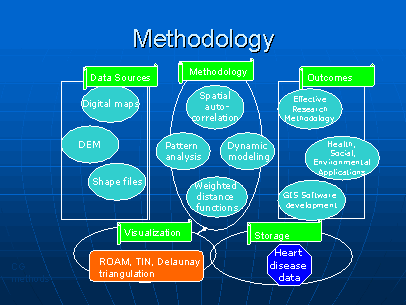| |
| The focus of SPARCS Lab is on the
development of new methodology based on the weighted
distance function and autocorrelation analysis for study
of the spatio-temporal phenomena on the example of
health and socio-environmental factors. SPARCS Lab also
focuses on the recent problems arising in the above
areas, with the goal of identifying key issues, and
providing efficient solution for research and industry. |
| The
projects on which we are working on are focusing on the
understanding the causes and the factors influencing
instances and treatments of heart disease in Alberta
using spatial analysis, autocorrelation, geometric
models and 3-dimensional visualization techniques. The
other related projects are investigating how population
distribution, social and economical factors, and traffic
influence the outcomes of the treatment accessibility
and availability of the treatments. Among the other
initiatives, we are focusing on satellite image
real-time rendering and restoration, as well as marine
traffic security and navigation issues. |
| General
Research Topics
|
-
Computational
methods in spatial analysis
-
nInvestigation
of spatio-temporal phenomena
-
nApplication
of the spatial analysis to health and social sectors
-
nGIS
real-time terrain modeling and visualization
-
nAutocorrelation
studies using weighted distance functions
-
nMethods
for selection of Lp norms for city planning
-
nDynamic
grid-based approach to statistical analysis of
census and
population data
-
nPattern
matching and point pattern analysis using
computational
geometry methods
-
nApplication
of the Voronoi diagram and Delaunay triangulation
methodology to GIS problems
|
|
These general research directions could be further
classified and described as following: |
| |
|
| Spatial
Analysis |
 |
n
To
develop the methodology for
spatial
autocorrelation
analysis based on the weighted
metric functions
n
To
identify the set of applied
problems for which the
methodology would
result in the significant
improvement over existing methods
for spatial analysis, as well as
public/private sector agencies
that would benefit from such
developments
n
To
analyze the spatial variation of
heart disease and
investigate the
relationship between disease
incidence and lifestyle indicators
n
To
link socio-economic, geographic
and environmental
factors to enhances
the predictive capacity of the
model
|
 |
|
|
Traffic
modeling and navigation
|
 |
n
To
apply the proposed metrics for the
measurement of distance
for route design and
the provision of routine and emergency
services, and optimal facility
location using location-allocation
models.
nTo
implements the uni- and multi-variate
(auto)correlation
indices and to
definition the topology based
contiguity among different spatial
objects.
nTo
investigation spatial patterns of
traffic routes using advanced
computational
methods, closely
related to the methodology such as
point and line patter Voronoi diagram.
|
 |
|
|
| |
|
Data
Structures and Visualization
|
 |
To develop
advanced 3D visualization too for
adequate representation for the
studies models
To develop
methodology based on adaptive memory
subdivisions and their topological
properties to efficiently render the
model
To process
high-resolution satellite images
containing geographical information and
eliminate possibility of an error
To find an
efficient representation for ship
navigation routes based on graphs
|
 |
|
|
Social
and Health Studies
|
 |
To
study accessibility of health care
facilities through the development
of
a
dynamic model for the detection of
spatio-temporal trends. The model
can serve for cross-temporal
comparisons, and for studying the
evolution of the functional
parameters, their statistical
significance, and their elasticity
To
study the
use alternative distance metrics for
an accurate measurement of the spatial
autocorrelation in the data
To investigate the dependence of
socio-economic factors on
accessibility and availability of the
treatment and the relationship of the
efficiency of the treatment on travel
time
|
 |
|
|
| |
|
|
| SPARCS Research methodology
can be represented as the following flowchart; |
|
 |
| |
| |
|
|
|
|
|
|